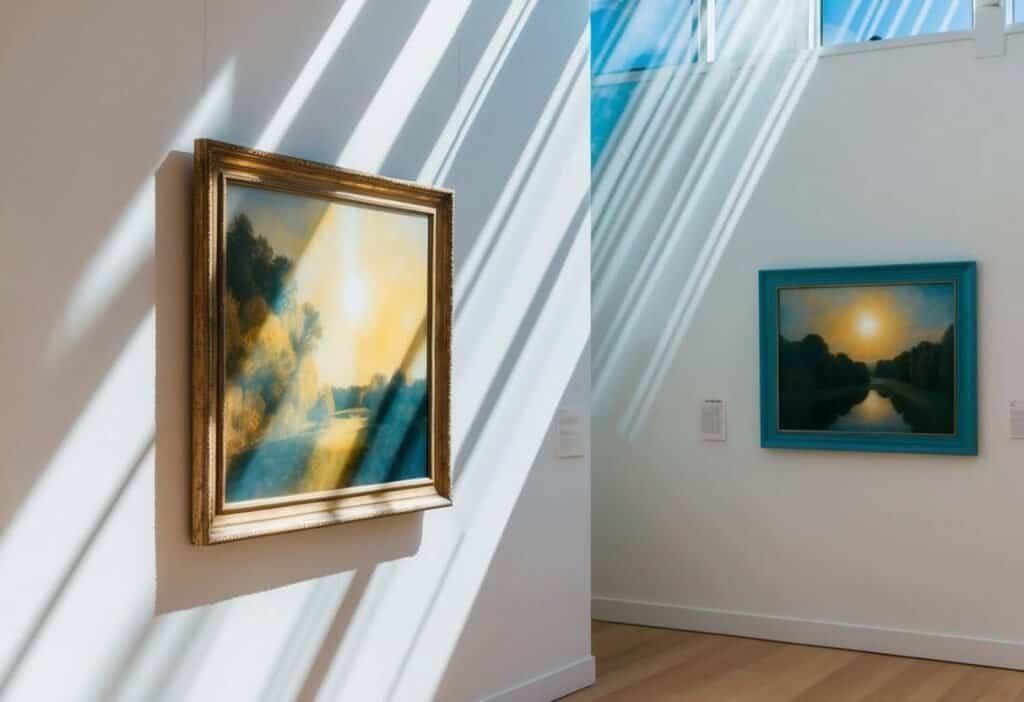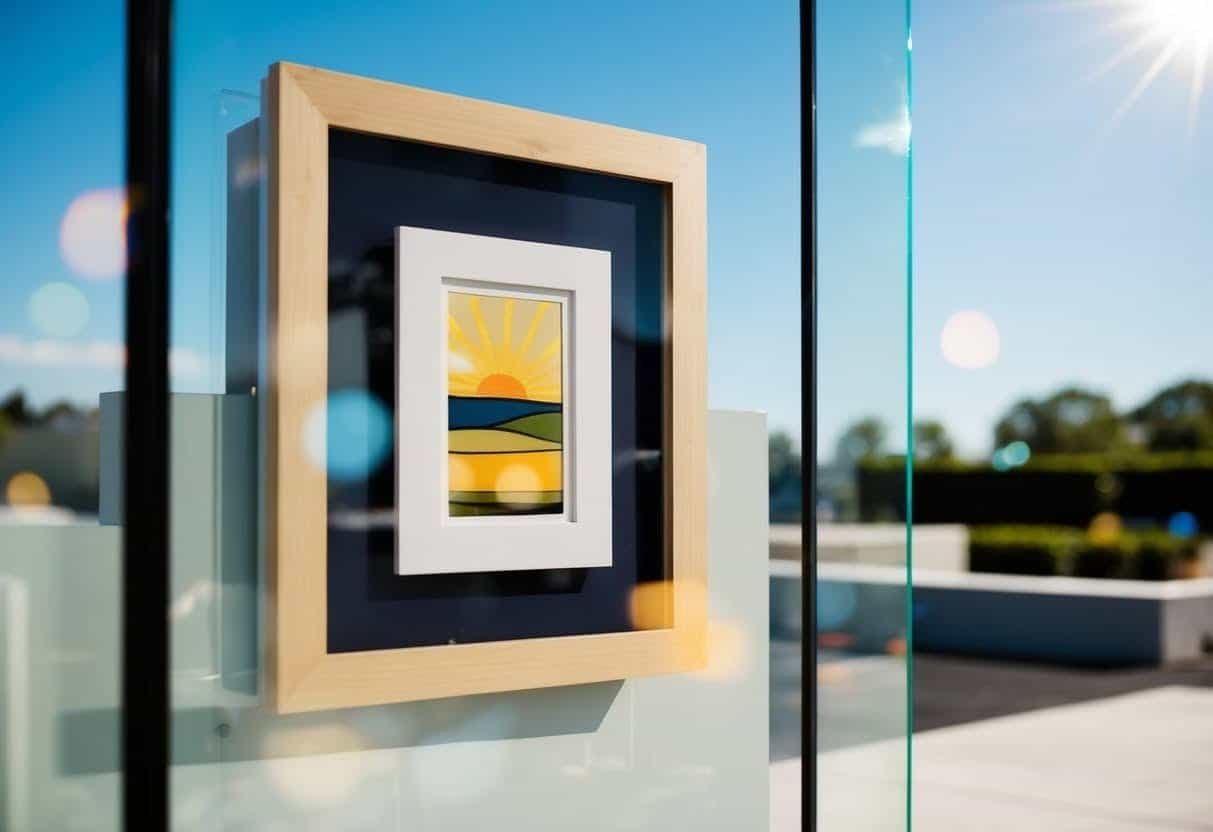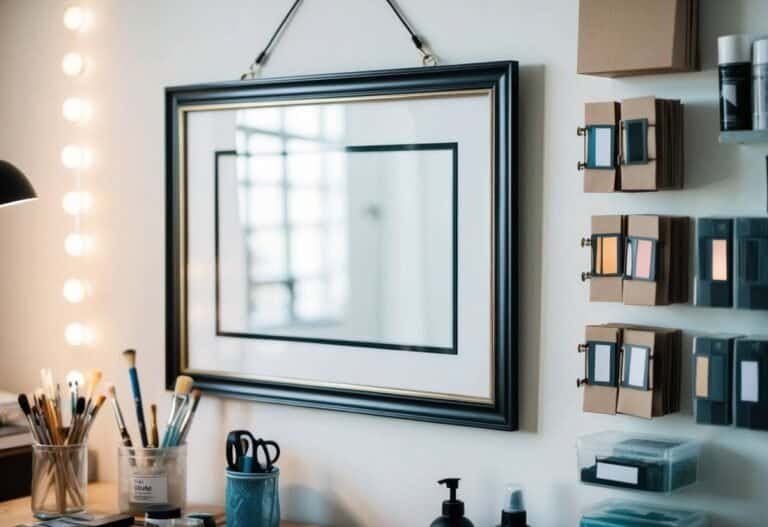Why UV-Protective Glass Matters: Essential for Art Preservation
Sunlight streaming through windows can cast beautiful light on artworks inside your home. Yet, it carries an unseen threat: ultraviolet rays. These rays can fade and damage cherished art pieces over time.
UV-protective glass serves as a crucial shield, preserving the vibrant colors and details of your valued artworks.
Incorporating UV-protective glass when framing pieces is a wise decision for any art collector. Not only does it safeguard against fading, but it also helps maintain the integrity of the artwork’s materials.
This type of glass works by blocking harmful UV rays, reducing the risk of damage that can lead to costly repairs or loss of the artwork’s original appearance.
Taking steps beyond just the framing can further enhance protection.
Proper placement of art, avoiding direct sunlight, and considering expert conservation advice are essential practices.
Armed with the right knowledge and tools, anyone can ensure their artwork remains in peak condition for years to come.
Key Takeaways
- UV-protective glass prevents fading and damage from sunlight.
- Choosing the right protection maintains art’s integrity.
- Additional techniques enhance art preservation.
The Science of UV Light

Ultraviolet (UV) light is a significant factor in art conservation due to its ability to cause damage over time. Understanding UV rays and their effects, alongside how they specifically harm artworks, is crucial for protecting valuable pieces.
Understanding UV Rays and Their Effects
UV rays are a type of electromagnetic radiation. These rays come from the sun and have shorter wavelengths than visible light.
UV rays are invisible to the human eye but can cause skin damage and sunburns. They are categorized into three types: UVA, UVB, and UVC.
UVA rays can pass through glass and lead to skin aging. Meanwhile, UVB rays are responsible for sunburns. Lastly, UVC rays are mostly absorbed by the Earth’s atmosphere.
Overexposure to these rays can lead to various forms of damage to materials and surfaces, altering their chemical makeup.
How UV Light Causes Artwork Damage
Artworks, particularly those with organic materials like paints, fabrics, or paper, are very sensitive to UV light. Long exposure can lead to fading, discoloration, and even breakdown of materials.
This process occurs because UV light causes chemical reactions in the pigments and dyes.
This light can break down organic materials in art, leaving once vibrant colors dull and lifeless.
Paintings, photographs, and textiles are particularly vulnerable. Even indirect exposure can cause damage over time.
Special UV-protective glass or coatings can help mitigate this issue by filtering out harmful rays and preserving the integrity of the artwork.
The Importance of UV Protective Glass

Artworks can easily fade when exposed to sunlight.
UV protective glass helps prevent this by blocking harmful rays. Here, learn about the benefits of using this special glass and explore the different types available.
Benefits of UV-Filtering Glass
UV-filtering glass shields art from the sun. Too much light makes colors fade. Paintings, photos, and prints keep their brightness longer with this glass. Museums and galleries often use UV-blocking solutions to save art.
This special glass also prevents material damage. UV rays can weaken paper and canvas. Long-term exposure can cause cracks. Protective glass can help avoid these issues, preserving art for years to come.
Different Types of UV-Protective Glass
Several kinds of UV-protective glass exist.
Acrylic and laminated options are lighter and safer. They are less likely to break than regular glass. For public spaces, choosing these types can be beneficial.
Anti-reflective coatings are another choice. They offer clear views without glare, making them popular for display situations.
Each type has unique features, allowing users to match the glass to their specific needs.
Selecting the Right Protection for Your Art

Choosing the right protective glass for your artwork is crucial. It’s important to weigh the benefits of museum glass against regular glass and consider acrylic options like Plexiglas for added protection and different visual effects.
Museum Glass vs. Regular Glass
Museum glass offers superior protection. It blocks up to 99% of UV rays, which can prevent fading and damage to artwork over time.
Non-reflective properties enhance viewing by reducing glare, making details more visible.
Regular glass is less costly but provides minimal UV protection. Over time, this could lead to noticeable color fading.
While regular glass may seem like a budget-friendly choice, the potential harm to artwork could outweigh savings.
Acrylic vs. Glass Options
Acrylic, including Artglass Lifetime Acrylic, is lightweight and shatter-resistant, providing a safe option for valuable art. It filters out harmful UV rays, similar to museum glass.
Plexiglas is another acrylic option that offers a clear view while protecting against UV exposure. Acrylic is easy to handle and install, making it ideal for large pieces or art that is frequently transported.
It does, however, scratch more easily than glass, so careful handling is essential.
Conservation Techniques Beyond Glass

In addition to using UV-protective glass, it is important to consider other methods to preserve art. These techniques include controlling the environment where the art is displayed and ensuring proper handling and storage.
Environmental Control in Display Settings
Environmental factors play a crucial role in preserving art.
Temperature and humidity must be carefully monitored. Keeping the temperature between 65-75°F and humidity around 40%-50% helps reduce the risk of damage.
Extreme temperatures can cause paintings to crack or warp. Meanwhile, art pieces, especially those made from organic materials, are sensitive to fluctuations. An air conditioning system can help maintain stable conditions.
UV filters on windows and doors prevent harmful rays from fading colors. For lighting, use bulbs that emit little or no UV radiation. This minimizes the degradation caused by light exposure.
Proper Handling and Storage
The way art is handled and stored significantly impacts its longevity.
Clean, dry hands or gloves should be used when handling pieces to prevent oils and dirt from transferring to surfaces.
Avoid leaning or stacking artworks, which can cause bending or scratching.
Art storage should be in a cool, dry place. Shelves and storage units should be sturdy and designed to support artworks safely.
Wrap pieces in acid-free materials to protect them from dust and environmental pollutants.
Labeling helps keep track of items in storage. This practice makes finding and retrieving art easier and reduces the need for excessive handling, which can lead to damage.
Framing Artwork for Maximum Protection

To protect art from sun damage, using the right frames and techniques is crucial. Consider materials, glazing, and display methods to preserve your artwork’s condition.
Choosing the Right Frame and Matting
Using acid-free matting is essential to prevent damage over time. Acid-free mats ensure no harmful chemicals seep into the artwork.
When selecting a frame, consider sturdy materials that can provide support and protection. Wood and metal frames are popular for their durability.
Conservation-grade glazing like UV-protective glass is important to shield art from harmful light.
UV glass significantly reduces light exposure, preventing fading and deterioration. It’s a smart choice to extend the life of valuable pieces.
Advanced Framing Techniques
Special techniques can further protect art.
Floating frames allow air circulation around the piece, reducing condensation risks. This setup is particularly useful in areas with fluctuating temperatures.
Proper sealing methods can prevent dust and dirt from reaching the art. A fitted, sealed backing helps maintain the artwork in pristine condition, shielding it from environmental damage.
Framers often use archival-quality materials to ensure longevity and protect against degradation.
Maintaining and Preserving Art Value

Art collectors and museums understand the importance of maintaining their collection’s value. UV-protective glazing plays a crucial role in preserving the monetary value of artworks by preventing sun damage. Additionally, employing long-term strategies ensures that art pieces remain in prime condition for years.
Impact of UV Protection on Monetary Value
Sunlight can fade and discolor art, reducing its market value.
Using UV-protective glazing, like Artglass AR 70 and Artglass AR 99, protects artwork by blocking harmful UV rays. This protection minimizes color fading and material degradation, which are critical for maintaining art’s value.
Collectors invest considerably in their art. By safeguarding against UV damage, they preserve both the aesthetic appeal and financial worth of their pieces.
Museums also prioritize UV protection to maintain and enhance the collection’s long-term value. Protecting the art preserves public trust and interest, keeping exhibits both safe and attractive.
Long-term Preservation Strategies
Beyond UV protection, environment control is essential.
Maintaining stable temperature and humidity levels prevents material warping and decay. Sensitive art prints benefit from climate regulation combined with UV protection for maximum durability.
Regular inspections and conservation work play a vital role.
Professionals routinely check for signs of damage or wear, addressing issues before they escalate. They also recommend using specialized display cases designed to shield artworks from environmental threats.
Preserving art involves collaboration between curators, conservators, and collectors. Through using effective protection methods and ongoing care, art remains in peak condition, safeguarding both historical integrity and financial investment.
Options for UV-Protective Glass

Choosing the right UV-protective glass can significantly enhance the longevity and preservation of artworks. Different types of glass offer various levels of protection that can be crucial for preventing sun damage.
Assessing Popular UV-Protective Glazing Products
There are several popular options to consider.
Artglass AR 92 provides anti-reflective coatings and 92% UV protection. This makes it a reliable choice for most artworks.
Artglass UV 99 is designed for maximum protection, blocking 99% of harmful UV rays. This is ideal for light-sensitive pieces like oil paintings.
Artglass AR 99 Water White offers excellent clarity with the highest level of UV defense. Meanwhile, AR 99 Protect is a strong option for those who need both high UV protection and anti-reflective properties.
These products not only protect but also maintain the visual appeal of the artwork with minimal distortion.
Difference Between Standard and Conservation-Grade Options
Standard glass provides basic protection and is usually more affordable. However, it might not be suitable for pieces exposed to direct sunlight or those made with fragile materials.
On the other hand, conservation-grade options like Artglass products offer superior UV filtering.
These products often feature advanced coatings that preserve colors and details over time.
While more expensive, conservation-grade glass like Artglass AR 99 or Artglass UV 99 ensures artworks are well-protected from fading and damage.
These differences highlight the importance of choosing the correct type of glass based on the artwork’s specific needs and environment.
Taking Action Against Sun Damage

Sunlight can harm artwork. The ultraviolet (UV) rays can fade colors and weaken materials.
It’s important to protect your art pieces to keep them looking their best.
Use UV-protective glass to shield your art. This type of glass blocks harmful UV rays. It can be a key step in preserving your artwork.
Keeping artwork in less sunny areas of a room can also help.
If you cannot avoid direct sunlight, consider closing curtains or blinds during peak sun hours.
Regularly rotate your artwork. Moving art to different locations can reduce the chance of damage from constant light exposure.
Humidity and temperature control are also important.
Use dehumidifiers and maintain a stable room temperature to protect art materials from long-term damage.
Frames with UV protection might be more expensive, but they’re worth considering for valuable pieces.
Pricing, of course, varies based on size and material quality.








